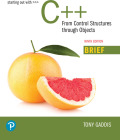
Group Project
25. Travel Expenses
This
• One student should design function main, which will call the other functions in the program. The remainder of the functions will be designed by other members of the team.
• The requirements of the program should be analyzed so each student is given about the same workload.
• The parameters and return types of each function should be decided in advance.
• Stubs and drivers should be used to test and debug the program.
• The program can be implemented as a multi-file program, or all the functions can be cut and pasted into the main file.
Here is the assignment: Write a program that calculates and displays the total travel expenses of a businessperson on a trip. The program should have functions that ask for and return the following:
• The total number of days spent on the trip
• The time of departure on the first day of the trip, and the time of arrival back home on the last day of the trip
• The amount of any round-trip airfare
• The amount of any car rentals
• Miles driven, if a private vehicle was used. Calculate the vehicle expense as $0.27 per mile driven
• Parking fees (The company allows up to $6 per day. Anything in excess of this must be paid by the employee.)
• Taxi fees, if a taxi was used anytime during the trip (The company allows up to $10 per day, for each day a taxi was used. Anything in excess of this must be paid by the employee.)
• Conference or seminar registration fees.
• Hotel expenses (The company allows up to $90 per night for lodging. Anything in excess of this must be paid by the employee.)
• The amount of each meal eaten. On the first day of the trip, breakfast is allowed as an expense if the time of departure is before 7 a.m. Lunch is allowed if the time of departure is before 12 noon. Dinner is allowed on the first day if the time of departure is before 6 p.m. On the last day of the trip, breakfast is allowed if the time of arrival is after 8 a.m. Lunch is allowed if the time of arrival is after 1 p.m. Dinner is allowed on the last day if the time of arrival is after 7 p.m. The program should only ask for the amounts of allowable meals. (The company allows up to $9 for breakfast, $12 for lunch, and $16 for dinner. Anything in excess of this must be paid by the employee.)
The program should calculate and display the total expenses incurred by the businessperson, the total allowable expenses for the trip, the excess that must be reimbursed by the businessperson, if any, and the amount saved by the businessperson it the expenses were under the total allowed.
Input Validation: Do not accept negative numbers for any dollar amount or for miles driven in a private vehicle. Do not accept numbers less than 1 for the number of days. Only accept valid times for the time of departure and the time of arrival.
Want to see the full answer?
Check out a sample textbook solution
Chapter 6 Solutions
EBK STARTING OUT WITH C++
- Draw an ERD that will involve the entity types: Professor, Student, Department and Course. Be sure to add relationship types, key attributes, attributes and multiplicity on the ERD.arrow_forwardDraw an ERD that represents a book in a library system. Be sure to add relationship types, key attributes, attributes and multiplicity on the ERD.arrow_forward2:21 m Ο 21% AlmaNet WE ARE HIRING Experienced Freshers Salesforce Platform Developer APPLY NOW SEND YOUR CV: Email: hr.almanet@gmail.com Contact: +91 6264643660 Visit: www.almanet.in Locations: India, USA, UK, Vietnam (Remote & Hybrid Options Available)arrow_forward
- Provide a detailed explanation of the architecture on the diagramarrow_forwardhello please explain the architecture in the diagram below. thanks youarrow_forwardComplete the JavaScript function addPixels () to calculate the sum of pixelAmount and the given element's cssProperty value, and return the new "px" value. Ex: If helloElem's width is 150px, then calling addPixels (hello Elem, "width", 50) should return 150px + 50px = "200px". SHOW EXPECTED HTML JavaScript 1 function addPixels (element, cssProperty, pixelAmount) { 2 3 /* Your solution goes here *1 4 } 5 6 const helloElem = document.querySelector("# helloMessage"); 7 const newVal = addPixels (helloElem, "width", 50); 8 helloElem.style.setProperty("width", newVal); [arrow_forward
- Solve in MATLABarrow_forwardHello please look at the attached picture. I need an detailed explanation of the architecturearrow_forwardInformation Security Risk and Vulnerability Assessment 1- Which TCP/IP protocol is used to convert the IP address to the Mac address? Explain 2-What popular switch feature allows you to create communication boundaries between systems connected to the switch3- what types of vulnerability directly related to the programmer of the software?4- Who ensures the entity implements appropriate security controls to protect an asset? Please do not use AI and add refrencearrow_forward
 C++ Programming: From Problem Analysis to Program...Computer ScienceISBN:9781337102087Author:D. S. MalikPublisher:Cengage LearningProgramming Logic & Design ComprehensiveComputer ScienceISBN:9781337669405Author:FARRELLPublisher:Cengage
C++ Programming: From Problem Analysis to Program...Computer ScienceISBN:9781337102087Author:D. S. MalikPublisher:Cengage LearningProgramming Logic & Design ComprehensiveComputer ScienceISBN:9781337669405Author:FARRELLPublisher:Cengage Microsoft Visual C#Computer ScienceISBN:9781337102100Author:Joyce, Farrell.Publisher:Cengage Learning,
Microsoft Visual C#Computer ScienceISBN:9781337102100Author:Joyce, Farrell.Publisher:Cengage Learning, C++ for Engineers and ScientistsComputer ScienceISBN:9781133187844Author:Bronson, Gary J.Publisher:Course Technology Ptr
C++ for Engineers and ScientistsComputer ScienceISBN:9781133187844Author:Bronson, Gary J.Publisher:Course Technology Ptr EBK JAVA PROGRAMMINGComputer ScienceISBN:9781337671385Author:FARRELLPublisher:CENGAGE LEARNING - CONSIGNMENT
EBK JAVA PROGRAMMINGComputer ScienceISBN:9781337671385Author:FARRELLPublisher:CENGAGE LEARNING - CONSIGNMENT Systems ArchitectureComputer ScienceISBN:9781305080195Author:Stephen D. BurdPublisher:Cengage Learning
Systems ArchitectureComputer ScienceISBN:9781305080195Author:Stephen D. BurdPublisher:Cengage Learning





